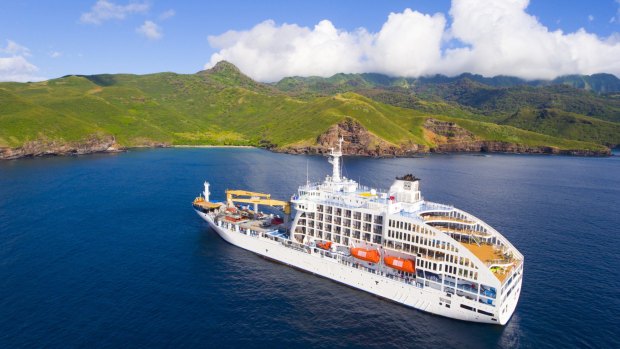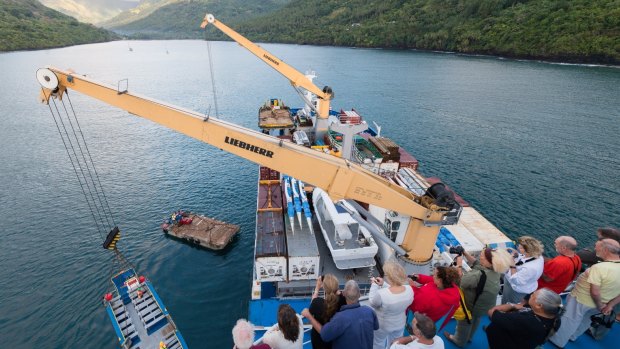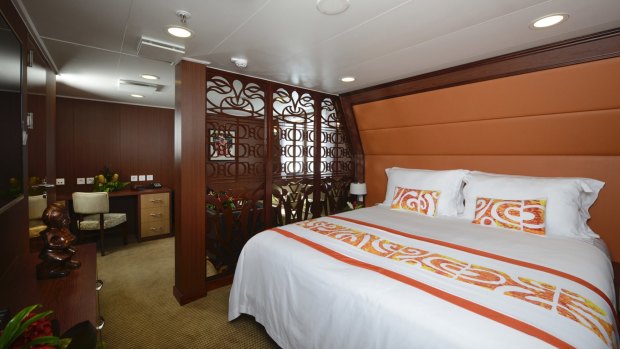By Tony Wheeler

The Aranui looks like the weird offspring of a love affair between a cargo freighter and a passenger liner.
"It's my third trip on the Aranui," a passenger from Brisbane tells me. "I've enjoyed them so much that this time I brought the whole family, including the grandchildren."
They are certainly the youngest children on board – in fact the only children on board – but they fit right in, as does everybody else, American, Belgian, Canadian, English, German, New Zealanders and Swiss, but overwhelmingly French. Although that French definition requires some clarification. Detailing the nationalities as we sail out of Papeete, the capital of Tahiti, the Polynesian crew insist that the passenger list features two distinct types of French citizens – French Pacific island residents and a larger number of citizens of "metro France". That is to say, as the crew spokesman emphasises with a haka-like shrug: "Invaders."
I am on the Aranui 5, undoubtedly the most unusual cruise ship in the South Pacific. Except it's not a cruise ship, the Aranui looks like the weird offspring of a love affair between a cargo freighter and a passenger liner. From the bow back to the bridge, the story is clearly cargo, with stacked containers, a curious mix of other goods (the odd smaller boat, even a Land Rover) plus an assortment of forklift trucks and the cranes to shift everything around. Then from the bridge back to the stern it suddenly becomes a gleaming white cruise ship.

Since being on a freighter is a big part of the Aranui attraction, you certainly spend some time watching the cargo activity.
Earlier versions of the Aranui – "great highway" in the Polynesian-Maori language – were strictly cargo, until the 1980s when the Aranui 1 added passenger cabins to the cargo capacity which quickly proved surprisingly popular. I'd seen the Aranui in a French Polynesian port over 20 years ago and instantly added a cargo-carrying island voyage to my bucket list.
The idea of joining a Polynesian cargo ship as it dropped off and picked up cargo from island to island clearly appealed to many others as well, and as a result the Aranui has gone through a series of reincarnations, each time adding more passenger cabins and more cargo capacity.
The Aranui 5 can carry modern containers and up to 254 passengers, although this voyage only has 119. Every month the Aranui 5 sails out of Tahiti and makes its way through the low-lying atolls of the Tuamotus on a 12-day voyage stopping at six of the spectacularly mountainous islands of the Marquesas.

The Aranui 5 has 103 cabins ranging from dormitory style, sleeping four to eight, to staterooms with private balconies.
Since being on a freighter is a big part of the Aranui attraction, you certainly spend some time watching the cargo activity. At every port the freight crew leap into action well before we arrive, shifting the loads around in a complicated chess game to clear space and rearrange the goods from above and below decks.
At only three of our 10 stops do we tie up dockside, and the slide-in-sideways docking operation at the island of Ua Pou certainly deserves a round of applause, particularly from the anchored cruising yachts we narrowly miss. At the other seven stops we drop anchor offshore and the Aranui's barges are craned off and loaded with the goods to carry ashore.
Docking at Ua Pou is impressive, but anchoring at Ua Huka is the "oh, wow" manoeuvering feat of the circuit. "Invisible Bay" is the perfect name for the narrow entrance into the port of Vaipaee and the Aranui performs an extraordinarily neat 180 degree rotation between the harbour sides before sort of backing into its anchoring point. The bay seems to be scarcely wider than the ship is long, as the bow and stern spin past the sheer rock faces.
Once ashore there is history, Polynesian and European, to explore. Hiva Oa features Paul Gauguin's grave, the museum dedicated to his artistic life and a reproduction of his "House of Pleasure". The island also has the grave, and a museum, for Belgian singer Jacques Brel who lived on the island 75 years after Gauguin.
There is birdlife, particularly on Ua Huka, the one inhabited Marquesan island which has managed to stay free of invading black rats and, as a result, is still home to endemic bird species.
Naturally we have some keen birdwatchers on board, binoculars and cameras always at the ready. Underwater there are lots of snorkelling opportunities and the Tuamotu atolls feature some of the finest scuba diving in the Pacific.
I have time to join a dive when we pause at the huge Rangiroa atoll on our way back to Tahiti, a site where divers often add a comment to their dive log: "Well, that was the most sharks I have ever seen on a single dive." Friendly reef sharks that is.
When it comes to local island history the stone tiki figures of the Marquesas are clearly related to their larger Polynesian brethren, the gigantic moai figures of Easter Island. So visits to archaeological sites featured regularly, including the Te I'Ipona archaeological site on Hiva Oa with the islands' biggest tiki collection.
An extraordinarily energetic drumming and dancing group who welcome us to the Kamuihei site on Nuka Hiva, grass skirts flying, tattoos rippling, underline another Polynesian Pacific connection: so this is where the Kiwi All Blacks got their rugby haka from.
At the end of our final dinner on the ship, on our way back to Tahiti, a particularly solidly built crew member demonstrates, to wild applause, the haka he likes performing with his wife.
There are enough of those archaeological sites to be explored so that at several islands you can get away from the larger group and make your own discoveries. Having checked Gauguin's and Brel's graves and museums in the town of Atuona, I hire a car with a couple of other archaeology fans and we drive to the nearby Taaoa site, where a sad, lonely tiki broods under a giant banyan tree.
At Ua Huka I climb up to the Meae Meiaute site to meditate with three rarely visited tikis, gazing down at the village of Hane below us on the coast. At the village of Omoa on Fatu Hiva there is time to seek out a wonderful collection of petroglyphs just outside the village, images of fishes and faces carved into a rock face.
Some of the fitter passengers then head off on a 15-kilometre hilltop hike to Hanavave, the island's second village, beautifully situated on the Bay of Virgins.
We enjoy stunning views as we arrive and depart many of our Marquesan ports, but the Bay of Virgins is clearly a case of saving the best for the last. "This is magic," one of the French passengers comments to me as we gaze back at our final magic view of the Marquesas and set course back to Tahiti.
THE DETAILS
CRUISE
The Aranui 5 has 103 cabins ranging from dormitory style, sleeping four to eight, to staterooms with private balconies. There are bars, a restaurant, swimming pool, a boutique, a rather small gym and – well Tahiiti is where they were invented – a tattoo studio.
The monthly 12-day circuit from Tahiti via the Tuamotu group to the Marquesas is the standard Aranui cruise, but trips also operate to other islands in French Polynesia and beyond, including to Rarotonga and the Cook Islands and once a year to remote Pitcairn Island, home of the Bounty mutineers.
Prices including all meals and wine and shore excursions range from about $5000 for a dormitory bed; $8000 a person in a stateroom, or $11,000 for the larger staterooms or rooms with balconies. See aranui.com
TOUR
In a hire car you can easily make a day circuit of Tahiti before or after an Aranui cruise. Taxis can be hard to find and are expensive, buses are reliable but time-consuming. The Museum of Tahiti & the Islands has been “under renovation” for years and is reopening “soon”. Meanwhile the House of James Norman Hall – the Mutiny on the Bounty author – is well worth a visit.
FLY
There are no direct flights, but connections via Auckland with Air New Zealand or Air Tahiti Nui are good. See airnewzealand.com.au or airtahitinui.com/au-en.
STAY
There are many hotels in Papeete or on the coast including the excellent InterContinental Resort Tahiti by the airport with rooms at about $600. Close to the centre of Papeete the Hotel Tahiti Nui – tahiti.com/hotels/hotel-tahiti-nui-2961 – has rooms at about $300 and is a short stroll from bars, restaurants and the waterfront when it’s time to board the Aranui.
Tony Wheeler with wife, Maureen, co-founded Lonely Planet 50 years ago next year after the couple travelled overland from the UK to Australia. Since then 150 million books under the Lonely Planet brand have been published.
Tony Wheeler travelled as a guest of Compagnie Polynésienne de Transport Maritime, the operators of the Aranui 5.
Sign up for the Traveller Deals newsletter
Get exclusive travel deals delivered straight to your inbox. Sign up now.